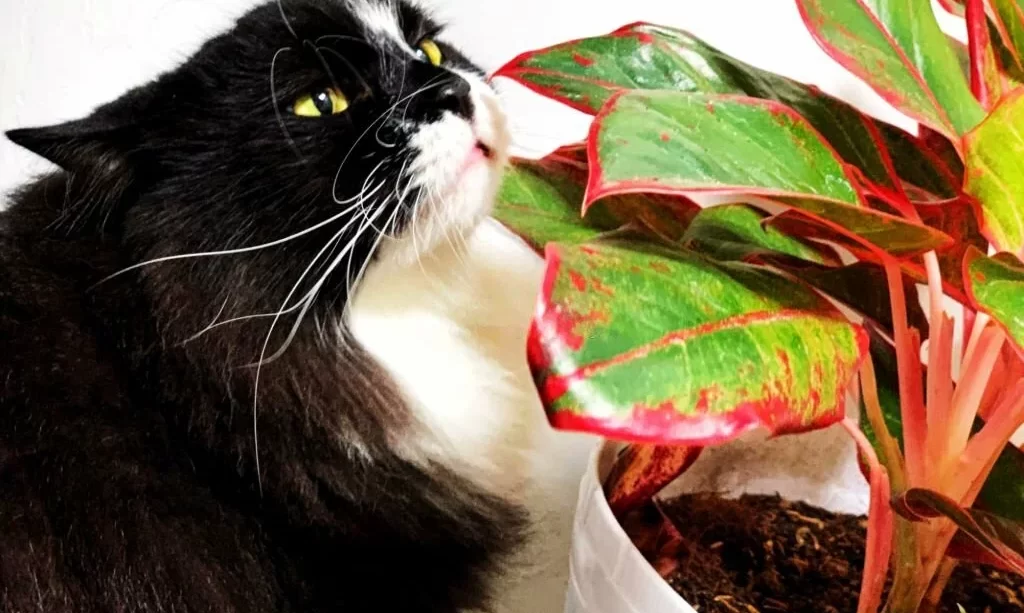Aglaonema plants have gained popularity in households as attractive, low-maintenance indoor ornamental plants. Their distinctive foliage, featuring a variety of patterns and colors, adds a touch of elegance to any living space. However, for cat owners, the question of safety arises: Are Aglaonema plants toxic to cats? In this article, we delve into the world of Aglaonema plants, exploring their characteristics and the potential risks they may pose to our feline companions. By understanding the components that can be harmful to cats, we aim to provide valuable insights to ensure the well-being of your beloved pets.
- LIVE INDOOR PLANT: Bring home a beautiful Chinese Evergreen for a tropical feel. These houseplants are lush and green, ready to liven up any space. They also improve room aesthetic, bringing a focal point to any living room, office, and bedroom décor
- STUNNING HOME DECOR: Chinese Evergreen arrives potted in a stylish plant pot, meaning you can unbox the plant and enjoy instantly. This pairing adds unique flair to any interior space, making Aglaonema a one-of-a-kind statement piece in any indoors space
- ELEVATE MOOD & WELLBEING: Plants make us happy. They give us life, fresh air and a sense of calm – all of which have the ability to lift your mood and improve your wellbeing. NASA studies show having plants improves mood, creativity and reduces stress
- GREAT GIFTING IDEA: Plants can be delivered to your loved ones for any occasion, including birthdays, anniversary, and housewarming. Enjoy peace of mind that every plant is well packaged, farm fresh, and ready to impress with your gift message
- AIR PURIFIER: Live Chinese Evergreen plants are known as air purifying houseplants, helping to remove harmful toxins and pollutants from the air that create a cleaner and healthier living environment for all to enjoy
What Are Aglaonema Plants?
Aglaonema, commonly known as the “Chinese Evergreen,” is a group of tropical perennial plants celebrated for their lush, broad leaves that exhibit striking variegation. These houseplants thrive in indoor environments, making them a popular choice for both experienced and novice plant enthusiasts. Their adaptability and aesthetic appeal have turned Aglaonema plants into a go-to option for those looking to introduce greenery into their homes.
Potential Toxic Components
Aglaonema plants contain insoluble calcium oxalate crystals, which are the primary toxic components to cats. If ingested, these crystals can lead to a range of adverse effects, including irritation of the mouth, tongue, and throat. These microscopic crystals can embed themselves in tissues, causing discomfort and distress to your feline companion. It’s crucial to be aware of these toxic components to ensure the safety of your pets when Aglaonema plants are present in your home.
Symptoms of Toxicity in Cats
Recognizing the symptoms of toxicity in cats that have ingested Aglaonema plants is essential for prompt intervention. Common signs of toxicity may include:
- Oral Irritation: Cats that have chewed or ingested Aglaonema leaves may exhibit signs of oral discomfort, including excessive drooling and pawing at the mouth.
- Gastrointestinal Distress: Cats may experience vomiting and diarrhea as their bodies react to the presence of the toxic components in the plant.
- Difficulty Swallowing: Swelling of the tongue and throat due to calcium oxalate crystals can make it difficult for cats to swallow food or water.
- Loss of Appetite: Cats may lose their appetite as a result of the discomfort caused by Aglaonema ingestion.
Safety Measures for Cat Owners
To ensure the safety of your cats and prevent potential Aglaonema toxicity, consider these safety measures:
- Plant Placement: Keep Aglaonema plants out of reach of your cats. Place them in areas where your pets cannot easily access them, such as on high shelves or in rooms with closed doors.
- Monitoring: Observe your cats around plants, especially if they are known to be curious or nibble on greenery. If you notice any attempts to chew the Aglaonema, relocate the plant to a more secure location.
- Cat-Friendly Alternatives: Consider cat-friendly houseplants that pose no threat to your pets, such as spider plants, catnip, or cat grass. These alternatives provide a safe way for your cats to interact with indoor greenery.
- Educate Family Members: Ensure that everyone in your household, including children, understands the potential risks associated with certain houseplants and is aware of the importance of keeping them away from pets.
- Emergency Response: If you suspect your cat has ingested Aglaonema leaves and displays any signs of toxicity, contact your veterinarian immediately. Prompt action can prevent further complications and discomfort for your pet.
By staying vigilant and taking these safety measures, you can enjoy the beauty of Aglaonema plants in your home while prioritizing the well-being of your feline companions.
What to Do If a Cat Ingests Aglaonema
If you suspect that your cat has ingested Aglaonema leaves, it’s essential to take immediate action. Follow these steps to ensure the well-being of your pet:
- Contact Your Veterinarian: Reach out to your veterinarian or an emergency animal poison control hotline immediately. Provide them with details about the situation, including the type of plant ingested and the symptoms your cat is experiencing.
- Observe Your Cat: Keep a close watch on your cat’s behavior and condition. Document any changes in their health or behavior to relay to the veterinarian.
- Do Not Induce Vomiting: Unlike some toxic ingestions, inducing vomiting is generally not recommended for Aglaonema ingestion. It may exacerbate the irritation of the mouth and throat.
- Follow Veterinary Advice: Follow the guidance provided by your veterinarian or the poison control hotline. This may include administering prescribed treatments or bringing your cat in for immediate medical evaluation.
Non-Toxic Houseplant Alternatives
For cat owners who want to maintain a green and pet-friendly environment, there are numerous non-toxic houseplant alternatives to consider. These plants pose minimal risks to your feline friends and can still add natural beauty to your home. Some cat-friendly alternatives include:
- Spider Plant (Chlorophytum comosum): Known for its air-purifying qualities, spider plants are safe for cats and are often a favorite for curious kitties.
- Catnip (Nepeta cataria): Catnip is a well-loved herb by felines and can be grown in pots or as an outdoor plant. It provides entertainment for your cat and is entirely safe.
- Cat Grass (Dactylis glomerata): Cat grass is a safe and enjoyable option for indoor cats, offering them a natural source of fiber and enrichment.
- Areca Palm (Dypsis lutescens): The areca palm is non-toxic to cats and makes an attractive addition to your home decor.
- African Violet (Saintpaulia): These colorful and compact plants are safe for cats and offer beautiful blooms.
- Aromatic leaves are a favorite among cats.
- Garden use: Containers, herb & flower beds.
- Culinary use: Fresh for cats & dried for cat sachets; also good in herbal tea.
- Grows well in partial shade.
- Plant during spring.
Conclusion
Aglaonema plants may be captivating and decorative, but their potential toxicity to cats requires careful consideration for pet owners. Understanding the signs of toxicity and implementing safety measures, such as plant placement and offering cat-friendly alternatives, is essential in creating a harmonious living environment for both your plants and your beloved feline companions. By taking responsible steps to ensure your cats’ well-being, you can enjoy the beauty of houseplants while keeping your pets safe and sound.






